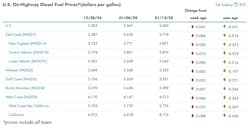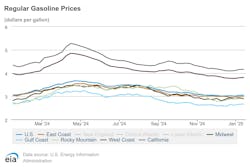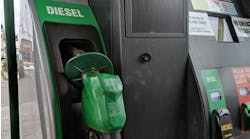The U.S. Energy Information Administration found that diesel prices across most of the nation continued to swing upward the week of Jan. 13. As of this week, the national on-highway diesel fuel price average is $3.602 per gallon, up 4 cents from last week, and down 26 cents from this time last year. Across the county, most prices rose from less than a cent to 9 cents.
The only place that did not see a price increase was the Rocky Mountain region, where diesel costs dropped 3 cents to $3.399. For other regions, prices rose the least in the Midwest and on the West Coast without California. In the Midwest, diesel costs jumped less than a cent to $3.532, while the West Coast without California went up 3 cents to $3.776 per gallon.
On the higher end of diesel price changes, the Gulf Coast saw its diesel prices increase 5 cents to $3.321, and the West Coast overall’s costs went up 6 cents to $4.213 per gallon. Along the East Coast, prices climbed 8 cents to $3.718, and California’s diesel costs jumped almost 10 cents to $4.716. Despite this, the Gulf Coast is the cheapest place to buy diesel at $3.321, and California is still the most expensive at $4.716.
As a point of comparison, the AAA motor club found that diesel prices for this week are $3.554, 5 cents less expensive than EIA. This current price is 4 cents more expensive than last week’s numbers of $3.511 but 38 cents cheaper than last year’s average of $3.935.
See also: Both gas and diesel prices rise in new year, diesel reaches $3.56/gal
National gas average hovers above $3/gal
While diesel prices generally increased this week, gas prices were more varied. The current U.S. average for regular gasoline is $3.043, down less than a cent from last week and only 1 cent less from this time last year. Otherwise, price shifts were relatively minimal for most regions, with many regions or sub-regions only seeing a less-than-one-cent change in prices or, at most, 3-cent shifts.
For the regions where gas prices decreased, the Rocky Mountain region’s gas prices fell 2 cents to $2.879 this week, while the Midwest’s dropped almost 4 cents to $2.899. As for where prices increased, prices rose less than a cent along both the East Coast (to $2.998) and in California (to $4.161 per gallon). Prices rose by 1 cent on the Gulf Coast and along the West Coast to $2.665 and $3.810, respectively, while the West Coast without California rose by 2 cents to $3.428.
For comparison, AAA’s gas average is currently $3.065, which is 2 cents more than the EIA’s numbers and less than a cent more than last week’s price of $3.064. By the AAA’s reckoning, this week’s price is also only 1 cent more expensive than last year's price of $3.071 per gallon.
According to Andrew Gross, AAA spokesperson, these minimal price shifts are in line with seasonal expectations for gasoline.
“Looking back at 2024, the high point for the national average was $3.67 on April 19, and the low was $3.01 on December 10,” said Andrew Gross, AAA spokesperson. “If the national average follows seasonal norms, it will probably waffle up and down by a few cents for the next two months.”





